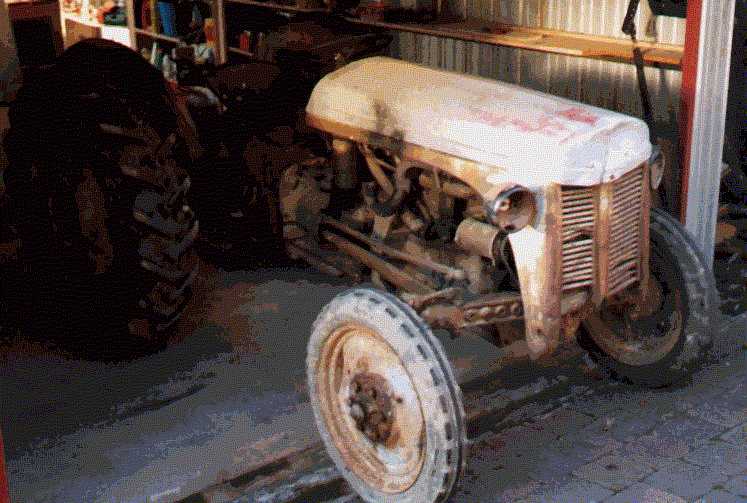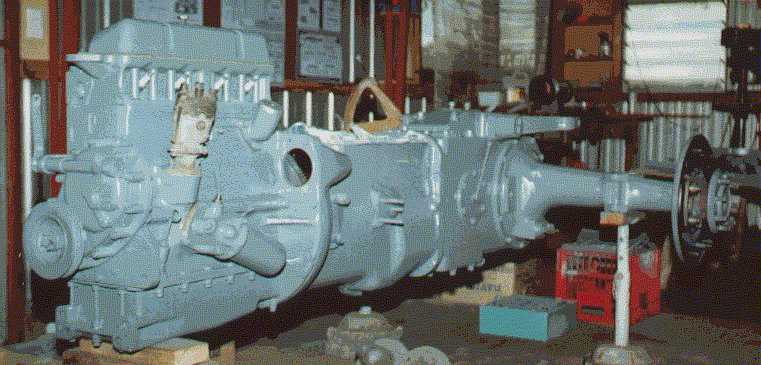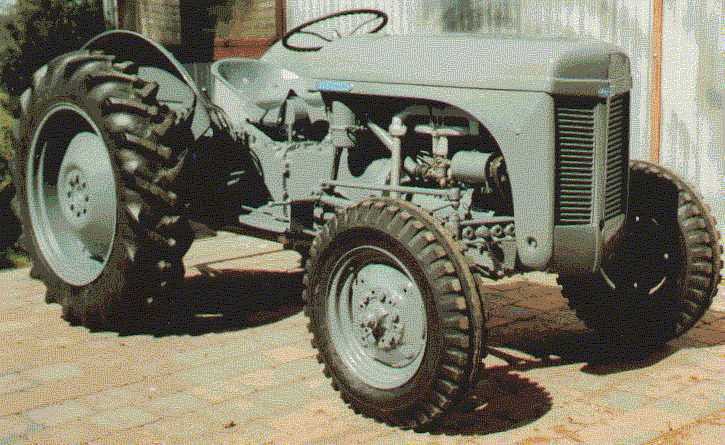
Restoration
Of A TEA Ferguson Tractor
Restoration of a Ferguson Tractor can be as large or smaller undertaking as you the owner wishes. The Ferguson tractor now in some case in excess of fifty years old generally ages well with only cosmetic restoration required. However there are some that have had an extremely hard life and have spent years out in the weather, to bring these back to pristine condition is quiet a job. I have included a short story on the restoration of my Tractor to give some people an insight into what is involved in restoring a Ferguson Tractor. It is a very rewarding project with the final outcome very pleasing indeed. Basic mechanical knowledge is all that is required and willingness to hop and get dirty and you have the two basic skills required to restore a Ferguson Tractor.
I am lucky in that I know some of the history of my Tractor and this is worth while knowing because it adds a certain something to owning a Ferguson Tractor. My tractor was purchased in Foster Victoria Australia in 1953 by a gentleman by the name of Sam my tractor for general use on his dairy farm. Several years later Alf , an Italian immigrant, purchased the dairy farm from Sam. This sale included farm machinery so my tractor had a new owner.
Alf was a concreter by trade and soon began to use my tractor off the farm. Alf was responsible for installing all of the concrete foot paths in the town center of Foster and my tractor was used extensively to help with this project. Later Alf sold his farm to concentrate on his concreting business, he kept my tractor. Alf then moved to Doncaster Victoria on the outskirts of Melbourne. Here he continued with his business as a general concreter he put my tractor to work with a carry all for moving gravel and cement, etc. He also had a rear grader blade used for leveling slab sites and. Wheel weights had also been fitted to its front 19" wheels.
Alf gradually wound down his business and with that my tractor became little used and neglected. My tractor spent several years in disrepair and out in the weather. Alf contacted the place of original purchase in Foster (which is still trading today with the son of the original proprietor know running the business) with the view to "Do it Up". Alf had my tractor returned to give it a restoration. Upon inspection of the tractor Alf was informed of the amount of money and time that would be involved and it was decided to give it a tune up and sell it instead.
After viewing my tractor at Foster for the first time in July 1998, I was impressed by the originality and genuine condition of the tractor. There were no patch up jobs hiding behind a fašade of bright shiny paint work. The bonnet was badly damaged, the radiator was beyond repair, also the front axle radius arms and steering arms were bent. The front axle housing was badly damaged and had to be replaced. There was a lack of compression on two cylinders and therefore a distinct lack of power. The rear hydraulics on the tractor seemed to be in perfect order with a smooth quick lift to them. The rear mudguards were in very good order with no major dents and only a little rust in the usual areas. The water pump was also leaking. Traces of my tractors heritage where present in a numbers of places as indicated by patches of concrete adhered in various places. With all this taken in I decided to pay the $800 dollars asking price and take my tractor home for a full restoration.
|
|
My Tractor in its Original Condition
Upon unloading my tractor at home the first job I undertook was to replace the water pump with a new unit and get my tractor running. We then tested oil pressure and gave it a bit of use to try to judge any other areas of concern. The clutch felt a bit sticky so we decided we would have a look at that later. The rear axle seals had been leaking quite a bit over the years and there was a build up of oil and muck all over the brake assemblies and insides of the rear wheels. The removal of both axles from the differential and replacement of the seals remedied this.
My tractor was driveable again at this stage so I tested the brakes and found them to significantly better then before. The next task was to replace the seal in the PTO shaft. I replaced the seal and returned the shaft to its rightful position without much problems. I also gave my tractor an oil change to flush some of the black muck out of the system before I pulled the motor apart. I found that my tractor still had one of the original Ferguson washable and reusable oil filters in it. Needless to say I did not wash and reuse the oil filter, I installed a new one.
I decided that the bonnet was too far gone to be restored so I purchased a better one. I did the necessary panel beating and welding etc. on this and the rear mudguards. I then sent them to be sand blasted and spray painted by a professional spray painter using two pack paint. I also had the dashboard and the petrol tank painted in this manner.
The motor was next on the list. I stripped it and found a large build up of carbon in the head and bores. I sent the head off for reconditioning and new valve guides were fitted. It was about this stage when my Father came to stay and his passion is engine reconditioning which was very convenient because I am not to keen on engine work myself. We removed the engine from the rest of the tractor and replaced the clutch disc. We then began on the motor, with it off the tractor we found a lot of mud and rust in the water jackets, worn piston rings, big end bearings with slight scores and slight marks in the bores. We then rebuilt the motor with new rings and bearings and honed the bores clean. The motor was then reattached to the tractor.
The front timing area was our next area of attention. We found the governor weight assembly to be badly worn and the timing chain to be very loose. A new timing chain and a good second hand governor weight assembly had this area of the tractor restored. The timing of the motor was checked and we moved on to other areas of the tractor.
The steering box was next on the agenda, I had already removed this to remove the seals on the steering shafts to send to my brother for restoration. There is no available reproduction seals so he has come up with a way to put modern rubber seals in the same original seal housing. We rebuilt this assembly without too many further hassles and painted it while it was off the tractor.
|
|
My tractor Just after a respray
It was about this stage when I took to my tractor with the electric drill and wire brush and removed the build up of rust, red Foster mud, concrete and even the odd bit of original Ferguson grey paint. I then sprayed the whole tractor with two coats of undercoat and one of top coat grey. We then started restoring the bits and pieces I had removed several weeks ago. As these where restored they where bolted back on, and My tractor started to take shape.
The wheels were the next area of attention. The front 19" wheels were far too rusted to be a viable proposition for restoration so I sourced a pair of 16" wheels in good condition to replace them. The rear wheels were a struggle to get the centers unbolted and probably had never been shifted to alter the rear track width. The wheels were then sent to be sandblasted. The front king pin and hub assemblies were then restored with replacement bearings and seals used through out. With the front axle in place the wheels were refitted to my tractor.
It was decided the radiator I had was too far gone to be restored, so I had been trying to get another one more suitable for restoration. After trying all the contacts I new of to no avail, I placed a call to a friend of mine at Foster, he had been keeping a close eye on how things were going and making sure it would be finished in time for Henty 1999 National Machinery rally. He managed to not only find a very good radiator but also a Fergy spanner and an oil pressure gauge (My tractors was smashed).
My tractor was now at the stage where there were four items remaining for restoration. They were the generator, starter motor, carby and distributor. We restored these items and rebolted the fuel tank in place, ran the new wiring loom (the original one had no insulation left on it). And we where ready to see if it would start.
The bonnet and mudguards where fitted back to the tractor. One of the last items to be restored was the rear lift arms. These were restored along with the leveling box and other linkages in this area and reattached to the tractor. My tractor had completed its restoration but I am sure there will be many hours spent in fiddling around with certain items and the restoration will probably never be finished. My tractors working days are now over and I plan to enjoy it for what it represents. The result of a very ingenious and well ahead of his time man, Harry Ferguson and the impact that his Fergy tractor had on the world. In the restoration of my tractor there have been many people who have been a great help to me and I offer them my heartfelt thanks for all of their assistance and advice. With out them the restoration of my tractor would have been a lot more difficult and the final product may have not been as good as it is today.
|
|
My
tractor after completion of restoration













